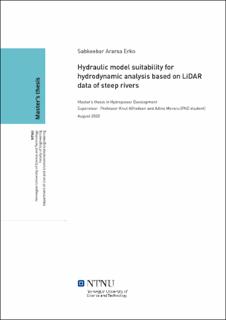| dc.description.abstract | A hydraulic model is an essential tool to estimate water depth, flow velocity, inundation extent, water surface elevation, and other hydraulic parameters. Different hydrodynamic models have been developed, and some of them have improved in efficiency and become more familiar. In recent decades, various studies have been done to improve the accuracy and reliability of flood mapping. However, the accuracy of the simulate results depends on many factors. For instance: the quality of the topographic data; the river gradient; the river reach length; the complexity of the topography; the consistency of the governing equation; and the numerical scheme can be influencing a selection of the appropriate model. Further, some models can carry out inundation extent estimation, others can execute water depth calculation accuracy, and some models can good perform in mountain rivers modeling.
In this study, two Norwegian rivers were selected to evaluate the performance of the HEC-RAS and TELEMAC-MASCARET models on a mild and a steep-sloped river. For the mild slope modeling, the LiDAR-based digital elevation model with high-resolution digital elevation was applied to simulate the Surna river hydraulics in HEC-RAS 2D and TELEMAC 2D models. The performance of both models was evaluated based on a standard deviation of residuals, particularly the root mean square error (RMSE), which simulated inundation extent was assessed against an observed inundation extent that provided by AHM from their original flight. In addition, the impact of the existence of islands and beds on the accuracy of hydrodynamic models was evaluated.
In regard to evaluating the model’s performance on a steep river, digital elevation and digital surface models were applied in both models to examine their functionality and verify the suitability of a LiDAR-based digital surface model, which obtained from https://hoydedata.no/LaserInnsyn/, in hydrodynamic computation. Issues such as the application of finite element and finite volume methods in the TELEMAC-MASCARET simulation for the steep river were assessed.
In both case studies, a comparison of models was based on simulated water depth, velocity, simulation time, and ease of use in the set-up. The results show that both models are performed well with mild slope, and an application of the finite volume method in TELEMAC-2D modeling functioned well for the steep river. | |
